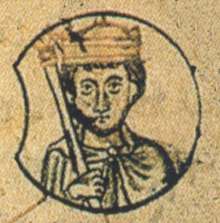982
Year 982 (CMLXXXII) was a common year starting on Sunday (link will display the full calendar) of the Julian calendar.
| Millennium: | 1st millennium |
|---|---|
| Centuries: | |
| Decades: | |
| Years: |
|
| 982 by topic |
|---|
| Leaders |
| Categories |
|
| Gregorian calendar | 982 CMLXXXII |
| Ab urbe condita | 1735 |
| Armenian calendar | 431 ԹՎ ՆԼԱ |
| Assyrian calendar | 5732 |
| Balinese saka calendar | 903–904 |
| Bengali calendar | 389 |
| Berber calendar | 1932 |
| Buddhist calendar | 1526 |
| Burmese calendar | 344 |
| Byzantine calendar | 6490–6491 |
| Chinese calendar | 辛巳年 (Metal Snake) 3678 or 3618 — to — 壬午年 (Water Horse) 3679 or 3619 |
| Coptic calendar | 698–699 |
| Discordian calendar | 2148 |
| Ethiopian calendar | 974–975 |
| Hebrew calendar | 4742–4743 |
| Hindu calendars | |
| - Vikram Samvat | 1038–1039 |
| - Shaka Samvat | 903–904 |
| - Kali Yuga | 4082–4083 |
| Holocene calendar | 10982 |
| Iranian calendar | 360–361 |
| Islamic calendar | 371–372 |
| Japanese calendar | Tengen 5 (天元5年) |
| Javanese calendar | 883–884 |
| Julian calendar | 982 CMLXXXII |
| Korean calendar | 3315 |
| Minguo calendar | 930 before ROC 民前930年 |
| Nanakshahi calendar | −486 |
| Seleucid era | 1293/1294 AG |
| Thai solar calendar | 1524–1525 |
| Tibetan calendar | 阴金蛇年 (female Iron-Snake) 1108 or 727 or −45 — to — 阳水马年 (male Water-Horse) 1109 or 728 or −44 |

Otto II (the Red) (955–983)
Events
By place
Europe
- Summer – Emperor Otto II (the Red) assembles an imperial expeditionary force at Taranto and proceeds along the gulf coast towards Calabria. In the meantime, Abu'l-Qasim (Kalbid emir of the Emirate of Sicily), declares a Holy War (jihad) against the Germans, but retreats his forces when he notice the unexpected strength of Otto's troops (not far from Rossano).
- July 13 (or 14) – Battle of Stilo: Abu'l-Qasim is cornered by the imperial German forces led by Otto II at Cape Colonna (south of Crotone). After a violent clash, the German heavy cavalry destroys the Muslim centre, killing al-Qasim in the initial fighting. The Saracens hold together, draws Otto into a trap, encircling and defeating his forces (killing around 4,000 men).[1]
- King Harald Bluetooth invades Norway, pillaging south-west Norway all the way to Stad, where he encounters Haakon Sigurdsson (the de facto ruler of Norway) and his army. He flees back to Denmark, ending the invasion.
Arabian Empire
- 'Adud al-Dawla, emir (king of kings) of the Buyid Dynasty, concludes a 10-year peace treaty with the Byzantine Empire. He establishes what will soon become the most important hospital of Baghdad.[2]
China
- October 13 – Emperor Jing Zong dies (during a hunting trip) after a 13-year reign. He is succeeded by his 12-year-old son, Sheng Zong, as ruler of the Khitan-led Liao Dynasty. His mother, Empress Dowager Xiao Yanyan becomes the regent.
By topic
Exploration
- Erik the Red establishes the first Viking colonies in Greenland (see 981).
Births
Deaths
- January 2 – Dětmar (or Dietmar), bishop of Prague
- July 13 (or 14) – Battle of Stilo:
- Abu'l-Qasim, Kalbid emir of Sicily
- Gunther, margrave of Merseburg
- Henry I, bishop of Augsburg
- Landulf IV, Lombard prince
- Pandulf II, Lombard prince
- October 13 – Jing Zong, emperor of the Liao Dynasty (b. 948)
- November 26 – Matilda, queen of Burgundy (or 981)
- Abu'l Haret Muhammad, Farighunid ruler (approximate date)
- Abu'l-Husain Utbi, Samanid vizier
- Al-Hasan ibn Ubayd Allah ibn Tughj, Ikhshidid prince and regent
- Eadwine, ealdorman of Sussex (approximate date)
- Gao Huaide, Chinese general (b. 926)
- Indra IV, Rashtrakuta ruler (India)
- Jordan, bishop of Poland (or 984)
- Otto I, duke of Swabia and Bavaria (b. 954)
- Senorina, Galician abbess and saint
- Shabbethai Donnolo, Jewish physician (b. 913)
- Wang Pu, Chinese chancellor (b. 922)
gollark: Package manager: `map`.
gollark: Compiler: `mac`.
gollark: `TheThingCannotActuallyBeThisThing`
gollark: `AntimemeticBeeoid`
gollark: Macron.
References
- Reuter, Timothy (1999). The New Cambridge Medieval History, Volume III, p. 255. ISBN 978-0-521-36447-8.
- "Islamic Culture and the Medical Arts_Hospitals". Retrieved November 8, 2011.
This article is issued from Wikipedia. The text is licensed under Creative Commons - Attribution - Sharealike. Additional terms may apply for the media files.